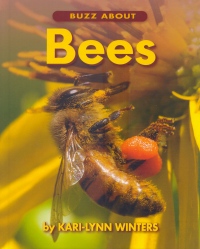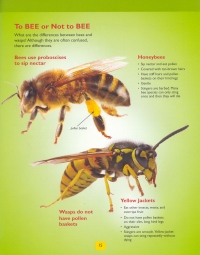| ________________
CM . . .
. Volume XIX Number 37. . . .May 24, 2013
excerpt:
With punny titles such as “UnBEE-lievable Body Parts” and “Let Me BEE: I’m BUZZ-y Working”, Buzz About Bees takes an upbeat, yet serious, approach to its topic. The biology and social structure of the world’s many bee species are described and illustrated in detail with plentiful colour photographs and drawn diagrams in the book’s six chapters.
The language is, at times, scientific but within the comprehension level of most readers. A glossary and index are provided, as is a list of books for further reading. The vocabulary is varied and slightly sophisticated – readers will not feel condescended to. The science of “responsible beekeeping” is presented in an appealing manner as an example of environmental stewardship. Beekeepers’ perspectives on bees and their own work are presented with photographs. A photo of a man with a bee beard is particularly striking, and close-up photographs of larvae will appeal to readers looking for the gross-out factor in science. Absorbing, cheerful, and easy to read, the book’s main drawback is the lack of explicitly comparative illustrations and identifying markers of the different bee species, allowing readers to easily identify the bees they find in their neighbourhoods. The author, Kari-Lynn Winters, was an elementary school teacher before completing her doctoral degree in literacy education. She currently teaches in Brock University’s Department of Teacher Education. She has several picture books and poetry books published; more are forthcoming. Recommended. Janet Eastwood is a student in the Master of Children’s Literature program at the University of British Columbia.
To comment
on this title or this review, send mail to cm@umanitoba.ca.
Copyright © the Manitoba Library Association. Reproduction for personal
use is permitted only if this copyright notice is maintained. Any
other reproduction is prohibited without permission.
NEXT REVIEW |
TABLE OF CONTENTS FOR THIS ISSUE
- May 24, 2013.
AUTHORS |
TITLES |
MEDIA REVIEWS |
PROFILES |
BACK ISSUES |
SEARCH |
CMARCHIVE |
HOME |

 Special emphasis is placed on human-bee interactions and the environmental and economic impact of these often misunderstood insects. Readers are encouraged to educate others about bees and to “BEE the Change the World Needs” by creating gardens with native plants, buying organic produce, building a nesting site for orchard mason bees (instructions and illustrations are given), and consuming local honey, as well as talking to teachers and politicians about the importance of bees. Other activities, such as a tag-like game and a recipe for a honey-lemon gargle, are included in the chapters and may appeal to recreational readers.
Special emphasis is placed on human-bee interactions and the environmental and economic impact of these often misunderstood insects. Readers are encouraged to educate others about bees and to “BEE the Change the World Needs” by creating gardens with native plants, buying organic produce, building a nesting site for orchard mason bees (instructions and illustrations are given), and consuming local honey, as well as talking to teachers and politicians about the importance of bees. Other activities, such as a tag-like game and a recipe for a honey-lemon gargle, are included in the chapters and may appeal to recreational readers.